はじめに: マーケットプレイスの市場とシナリオ
ファッションマーケットプレイスは、2030年までにファッションのオンライン販売総額の50%に達すると予想されており、このためファッションブランドは、ファッションマーケットプレイスの管理で成功するために必要なスキルをすぐに習得する必要があります。
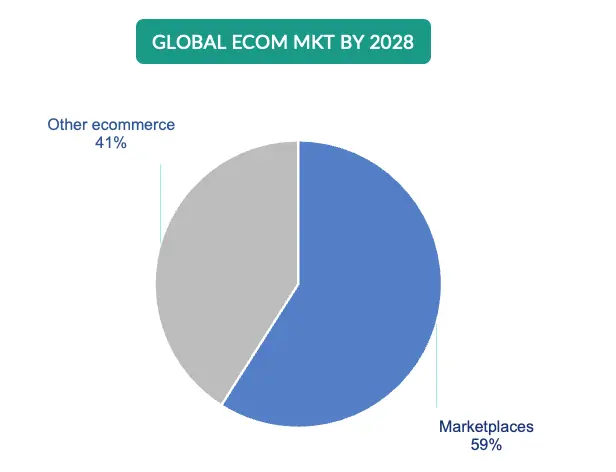
Marketplaces like Farfetch, MyTheresa and Zalando offer the opportunity to reach new consumers and increase sales volumes. However, large marketplaces put constraints to what brands can and can’t do and impose processes that fashion brands need to strictly follow if they want to be present on these fashion marketplaces online.
ファッションマーケットプレイスとは何ですか?
A fashion marketplace is an online platform that connects multiple fashion brands and retailers with consumers, allowing various sellers to showcase and sell their products in a centralized digital space. Unlike traditional e-commerce stores operated by single brands, these fashion marketplaces offer a diverse range of styles, price points, and brands, providing consumers with a comprehensive shopping experience. Whether it’s a mainstream online fashion marketplace or a niche luxury fashion marketplace, consumers can discover a wide variety of options.
Want to Master Marketplace Management?
Navigating the complex world of fashion marketplaces online requires careful planning and strategy. If you’re a fashion brand looking to optimize your presence across these platforms, keep reading this guide for expert insights. Plus, consider taking our Marketplace Management Online Course for an in-depth, hands-on approach to maximizing your sales and brand visibility across top platforms like Farfetch, MyTheresa, and Zalando. – leaders in the fashion online marketplace space.
What the Risks of Selling on Marketplaces?
Fashion Marketplaces present opportunities but also threats. For example, the high commissions fees that fashion brands have to pay to the marketplace fashion platforms, poses a significant threat to the 収益性 of the online ecommerce sales on fashion marketplaces.
Another important decision for fashion brands is whether or not selling on specific fashion marketplace platforms in order not to go into competition with the main ecommerce channel of the brand or with wholesale clients who are selling online on fashion marketplaces in specific regions. Decisions around luxury brand positioning also play a critical role when it comes to choosing the right platforms.
If you work in a fashion brands and you want to learn how to manage fashion marketplaces keep reading this guide and consider taking the マーケットプレイス管理オンラインコース. Learning to navigate marketplaces fashion effectively can help you scale while protecting your margins and brand image.
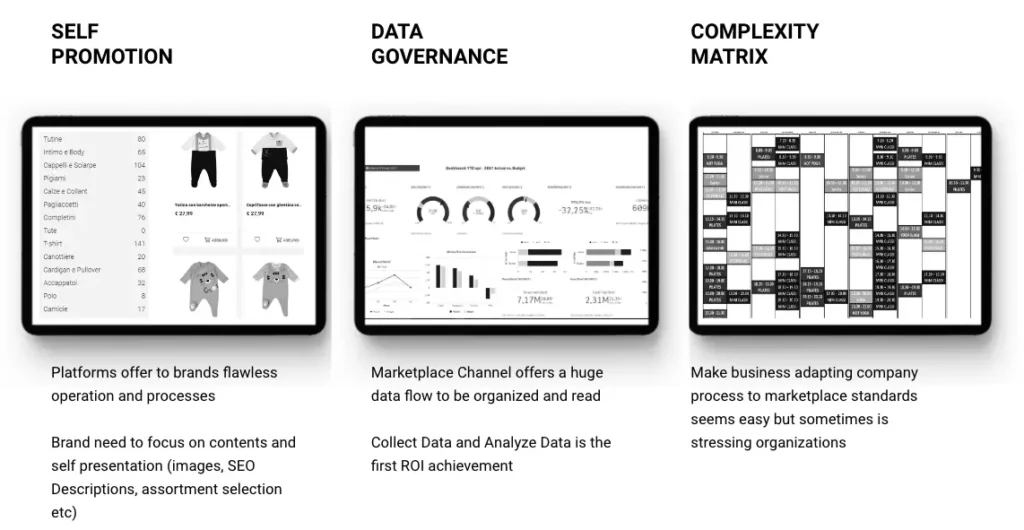
Use Cases: why selling on marketplaces.
A) The shoes brand A that is very strong in the southern Europe may utilize marketplaces in US and in the North of Europe to investigate the market potential leveraging the traffic of the marketplaces. For example the brand could integrate with Zalando, Galeries Lafayette and Miinto for the North of Europe and Neimann Marcus and Sacks Fifth Avenue for the US.
B) The clothing brand B needs to acquire new customers who may become brand lovers if they only tried the brand B products. The brand B decides to run a sales event on VeePee network where new customers can try the brand B products by buying the products with 50% to 70% discount. The happy customers will then become brands customer and buy also from the DTC ecommerce.
C) Brand C sells well jeans in North of Europe market but want to target people who buy total looks from luxury department stores, therefore Brand C decides to activate the Breuninger Marketplace and list a selection of products on the Department store’s marketplace so that the customers of the Department store can buy also the Brand C products when they shop for Looks
D) Brand D sees that its products are sold on a marketplace by a multitude of sellers who sell both second hand and new products, the Gross Merchandise value is estimated around 1 million Euros per year. The Brand D decides to open the official brand channel directly on the marketplace and acquired 75 percent of share of the brand sales on that specific marketplace.

さらに詳しい情報については、著者のEnrico Fantaguzzi、Filippo Quattroneまでお問い合わせください。著者について
Fashion marketplaces such as Farfetch, Zalando and Nordstrom offer a significant opportunity for fashion & luxury brands to 世界中の新規顧客にリーチする。 しかし、 この競争の激しい環境で成功するには戦略的なアプローチが必要です, tailored to the unique challenges of luxury brand positioning and a コストと収益の慎重な計画.
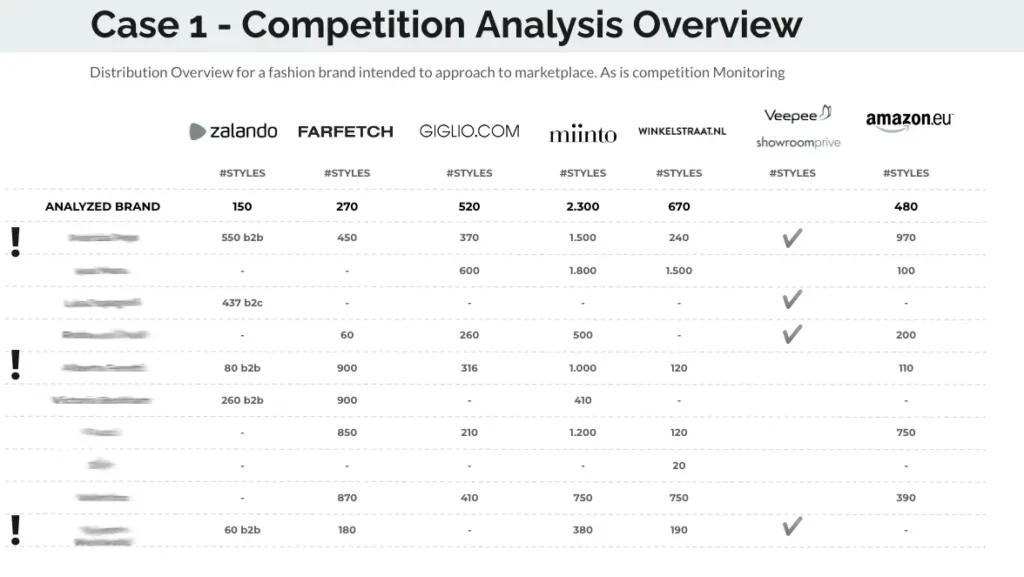
How Do the Marketplaces Work?
A fashion marketplace is an online platform that connects buyers and sellers 販売者はブランドであり、顧客は製品の最終消費者であるため、これはブランドにとっての B2C ビジネス モデルです。
Fashion marketplaces allow brands to virtually multiply the visibility of the products by publishing them on multiple sales channels (online marketplaces) while the products are sitting in the brand’s warehouse (Drop Shipping). These fashion marketplaces online enable scalable growth without upfront inventory relocation
Stock, prices, descriptions, images and fashion marketplace management strategy are controlled by the brand
Every time there is a sale on the fashion marketplace, the product is sold to the customer and shipped to the customer from the supplier – the brand or the seller.
Why Fashion Marketplaces Are a Major Opportunity for Fashion Brands
Selling on Marketplaces is important for fashion and luxury brands for a number of reasons:
- Internationalization: Marketplaces allow brands to reach new customers in many different countries.
- Low capex investments: Selling on online fashion marketplaces don’t require the set-up of an e-commerce platform and the costs are mainly variable.
- Low stock risk (Dropship Model): Fashion brands can sell the stock that they already have in their warehouse on multiple fashion marketplace online channels.
- New customer base: Markeplaces allow fashion brands to reach new customers.
- Reduce inventories: Marketplaces allow fashion brands to sell the same stock on different channels.
- Brand Image Control: The advantage of Marketplaces compared to resellers is that fashion brands can control price and image – crticial for luxury brand positioning.
- データの収集: Markeplaces で販売すると、分析する販売データをさらに収集できるようになります。
Ready to Maximize Your Brand’s Potential?
The fashion marketplace is an exciting and ever-evolving landscape, full of potential for brands aiming to grow their digital presence and reach new customer segments. From global giants like Zalando and Amazon to curated platforms like Farfetch and Yoox, each fashion marketplace offers unique opportunities to boost visibility, drive sales, and build brand recognition.
Success in this space isn’t just about showing up—it’s about mastering the rules, understanding the algorithms, and tailoring your strategies to each platform’s structure and audience. If you’re a fashion brand eager to tap into this goldmine of opportunity, learning how to effectively navigate and manage your fashion marketplace presence is not just beneficial—it’s essential.
Stay tuned for more expert insights, tips, and tools to help you thrive in the world of online fashion marketplaces.
A List of Fashion & Luxury Marketplaces With a Brief Description
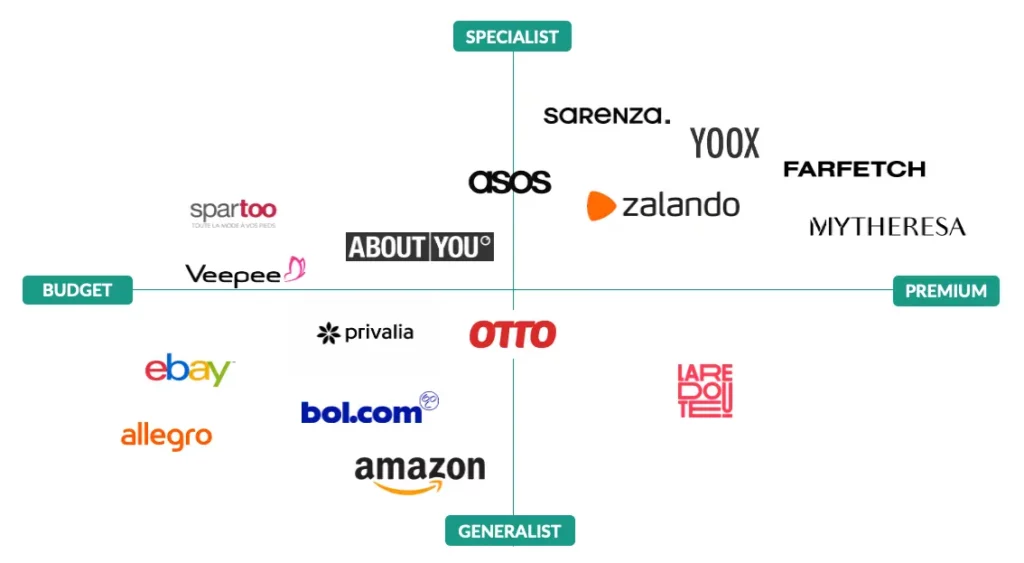
- ファーフェッチ: 高級ファッションブランドのグローバルマーケットプレイス。世界中のブランドと顧客を結び付け、高級ショッピング体験を提供します。最近、ケリンググループの一部のブランドがこのマーケットプレイスでの直接的な存在感を低下させ始めました。詳しくはこちら ファッションネットワーク.
- ブロイニンガー: オンラインマーケットプレイスを持つドイツの百貨店チェーン。さまざまなファッションブランドのほか、家庭用品やアクセサリーを取り扱っています。
- ユークス: 高級ブランドからコンテンポラリーブランドまで、さまざまなファッションブランドを販売するイタリアのオンライン小売業者。また、中古衣料品の再販マーケットプレイスも提供しています。
- ザランド: 手頃な価格から高級品まで、幅広いブランドを販売するドイツのオンライン ファッション小売業者。独立系ブランドのマーケットプレイスも提供しています。
- ミント: デンマークのファッションブランドのオンライン マーケットプレイス。ヨーロッパ各地のブランドと顧客を結び付け、幅広いスタイルの商品を提供しています。
- サックスフィフスアベニュー: オンラインマーケットプレイスを持つアメリカの高級デパート。ファッションブランドのほか、家庭用品やアクセサリーなど幅広い商品を取り扱っています。
- オトリウム: 世界中のファッションブランドを最大 70% 割引で提供するヨーロッパのフラッシュ セール マーケットプレイス。
- ヴィーピー: 世界中のファッションブランドを最大 70% 割引で提供するフランスのフラッシュ セール マーケットプレイス。
- 24s.com: 世界中から厳選したブランドを揃えたヨーロッパの高級ファッション マーケットプレイスです。
- 天猫: ファッション、家庭用品、電化製品など、幅広い商品を扱う中国のマーケットプレイス。高級ブランドのラグジュアリーセクションもあります。
- メイシーズ: オンラインマーケットプレイスを持つアメリカの百貨店チェーン。ファッションブランドのほか、家庭用品やアクセサリーなど幅広い商品を取り扱っています。
4. ファッションマーケットプレイスで成功する方法
ファッションマーケットプレイスで販売するための戦略
Success on an online fashion marketplace requires understanding the marketplace’s audience and aligning product offerings accordingly. High-quality images, detailed product descriptions, and competitive pricing are essential. Additionally, leveraging marketplace fashion promotions and participating in seasonal campaigns can enhance visibility on both mainstream and luxury fashion marketplace platforms.
可視性を高める商品リストの最適化
Optimizing your listings is a cornerstone of effective fashion marketplace management. Utilizing relevant keywords, clear titles, and comprehensive descriptions improves searchability within the marketplace. Incorporating customer reviews and maintaining high ratings also boost credibility and attract more buyers.
マーケットプレイスのアルゴリズムとプロモーションを活用する
Understanding and adapting to the marketplace’s algorithm can significantly impact product visibility. Engaging in promotional opportunities offered by the marketplaces – such as flash sales or featured listings, can drive traffic and increase sales. This is especially true for brands looking to strengthen their luxury brand positioning on curated fashion marketplaces.

最新情報を見逃さない
弊社のメーリング リストに登録して、トレーニング プログラム、求人情報、無料リソースに関する最新情報を受け取ってください。
What Are the Differences Between Drop shipping and Concession Models?
以下に、ドロップシッピングとコンセッションの主な違いをまとめた表を示します。
| 特徴 | ドロップシッピング | 譲歩 |
|---|---|---|
| 製品の所有権 | 販売者は商品を所有していない | 販売者は商品を所有していない |
| 在庫管理 | 販売業者は在庫を管理していない | 販売業者は在庫を管理していない |
| 配送 | 販売者は配送を取り扱っていません | 販売者は配送を取り扱っていません |
| 価格 | 商人が価格を決める | サプライヤーが価格を設定する |
| 手数料 | 販売者は手数料を受け取らない | 販売者は販売ごとに手数料を受け取る |
| マーケティング | 販売者はマーケティングを担当します | サプライヤーはマーケティングを担当します |
| 顧客サービス | 販売者は顧客サービスに責任を負います | サプライヤーは顧客サービスに責任を負います |
Pros and Cons of Drop Shipping and Concession Models
Both drop shipping そして concessions have their own advantages and disadvantages when selling on a fashion marketplace. ドロップシッピング is a more hands-off approach – often used in fashion marketplaces online, but it can be more difficult to control the customer experience.
譲歩, on the other hand, give the merchant more control over the customer experience within the fashion online marketplace, but it can be more time-consuming and require more upfront investment in fashion marketplace management.
The best approach for a particular merchant will depend on their specific goals and circumstances. If a merchant is looking for a low-cost, hands-off approach, then drop shipping may be the best approach. If a merchant is looking for more control over their brand image and customer journey – particularly in luxury fashion marketplaces – then the concession model may be the better approach.
ドロップシッピングとコンセッションのどちらかを選択する際に考慮すべき追加の要素は次のとおりです。
Markeplaces Integration and Workflow
注文管理とマーケットプレイスとの統合は非常に複雑になる可能性があり、正確な計画、定義、組織化が必要です。
マーケットプレイスでブランドの販売を組織する方法を今すぐ学ぶことができます マーケットプレイスオンラインコース デジタルファッションアカデミーによる。
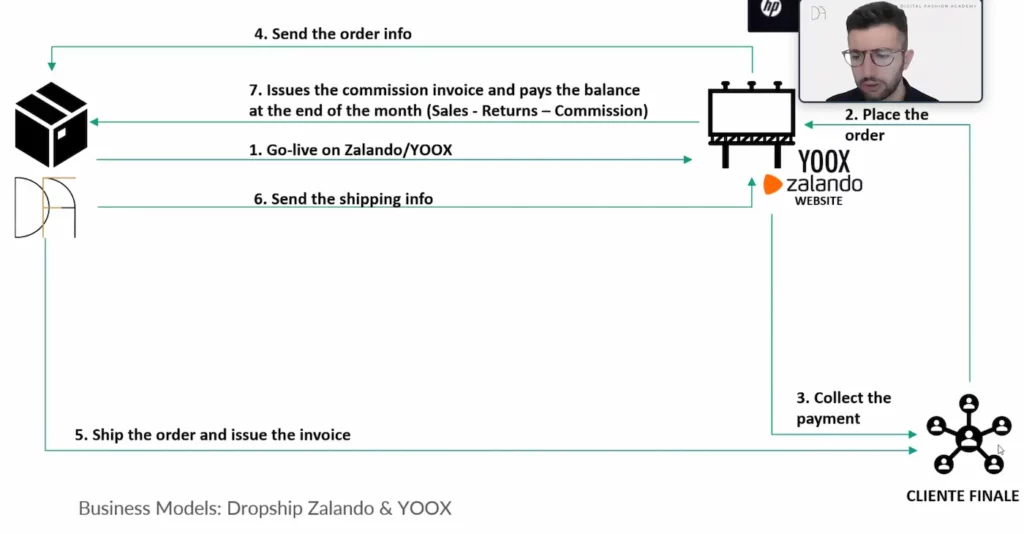
About the Authors

フィリッポ・クアトロネ
マーケットプレイスユニット責任者 – フィロブルー
ファッションブランドがマーケットプレイス チャネルをエンドツーエンドで活性化できるようサポートする戦略的経営コンサルタント。
彼は、Accenture、Ralph Lauren、Valentino、OVS で管理職を務め、さまざまな業界や国際企業で 15 年以上の経験を持っています。

エンリコ・ファンタグッツィ
デジタルファッションアカデミーの共同創設者
エンリコ・ファンタグッツィはファッションと高級品のeコマースのプロでありコンサルタントです。彼は次のようなブランドで働いてきました。 グッチ, トッズ, ウールリッチ そして、eコマースのような ユークス.
10 Questions About Fashion Marketplaces That We Answered in Our Online Course.
ファッション マーケットプレイスのビジネス モデルを詳しく検討し、ビジネス計画や統合などの特定の側面に取り組む前に、ファッション マーケットプレイスに関する最も一般的な質問に対する簡単な答えをいくつか紹介します。
- どのような状況でオンラインマーケットプレイスが有利になるのでしょうか?
- マーケットプレイスではブランドが 新しい市場を開拓する ブランドが特定の地域的強みを持っていない、またはブランド認知度が低い場合、ブランドはマーケットプレイスを利用して ブランド認知度と売上を拡大する.
- もう一つの状況は、ブランドの製品がすでにマーケットプレイスで販売されているが、多くの異なる販売者によって販売されている場合です。この場合、ブランドは チャンネルを制御する 直接販売することで。
- マーケットプレイスと Direct To Consumer (DTC) 電子商取引の間に共食い現象は起きていますか?
- カニバリゼーションが起きているかどうかを確認するには、 売り切れ価格を分析する そして カテゴリー別およびベストセラー別に販売された製品この分析結果に応じて、異なるチャネル間で潜在的な共食いや相乗効果があるかどうかを判断できます。このトピックの詳細については、 マーケットプレイスコース.
- オンラインマーケットプレイスで価格を管理するにはどうすればいいですか?
- ブランドはマーケットプレイスでの販売価格を監視できる。 特定のアプリケーションを使用する 市場をスキャンしてブランドに結果を提供する。オルタナティブファッションでは、ブランドは この分析をサービスプロバイダーに委託する ファッションブランドのマーケットプレイスをアウトソーシングで運営する企業。
- デジタルマーケットプレイスで販売するメリットは何ですか?
- データを収集する さまざまな市場における製品の好み;
- ファッション製品のライフサイクルを活用する 新製品をプレミアム チャネルで販売し、オフシーズン製品をディスカウント マーケットプレイスで販売する。
- 地元の市場に特化したマーケットプレイスは、ブランドが 特定の市場でブランド認知度と売上を伸ばす.
- マーケットプレイスではブランドが 新規顧客を獲得する 一般的に特定のマーケットプレイスで購入し、ブランド忠実な顧客へと変えていく人々です。
- マーケットプレイスで販売するためのルールは何ですか?
- マーケットプレイスで販売するには、配送や顧客サービスなど、マーケットプレイスのサービスレベル契約(SLA)に従う必要があります。
- 技術統合: コネクタ ソフトウェア、データフィード、マッピング仕様
- コンテンツガイドライン: 製品画像の説明、マーケットプレイスのブランドページコンテンツ。
- 可能かつ必要な場合には、マーケティングおよび広告キャンペーンを実施します。
- マーケットプレイスで販売するための前提条件は何ですか?
- マーケットプレイスで販売する前に、販売会社は準備を整えておく必要があります。 標準的なドロップシッピングプロセスをサポートする これには以下が含まれます:
- 物流 B2C 機能: ピッキング、梱包、出荷、在庫管理。
- 顧客サービス機能。
- デジタル制作機能(製品画像と説明)。
- マーケットプレイスでの価格競争を避けるにはどうすればいいですか?
- マーケットプレイスでの価格競争は、複数の販売者が1つ以上のマーケットプレイスに同じ商品を出品するときに発生します。最も一般的なケースは、卸売クライアントまたは小売業者がマーケットプレイスでも販売している場合です。たとえば、マルチブランドブティックがFarfetchで販売している場合などです。この状況を回避するために、ブランドは マーケットプレイスで直接チャンネルを開設するそうすることで、ブランドはマーケットプレイス上のブランド スペースを有機的に占有します。(ユース ケース D を参照)
- 社内で行うか、アウトソーシングするか、どちらが最適ですか?
- の1つ 最大の課題 マーケットプレイスで販売を始めるときに重要なのは マーケットプレイスのすべての仕様を学習して製品カタログを作成する マーケットプレイスが設定した基準に準拠する必要があります。ブランドが社内にスキルを持っていない場合、またほとんどの時間をマーケットプレイスでの作業に費やせる専任スタッフがいない場合は、このプロセスに数か月かかることがあります。マーケットプレイスの統合に外部のサービス プロバイダーを使用すると、市場投入までの時間を大幅に短縮できます。
- マーケットプレイスではどのような KPI を監視すべきでしょうか?
- マーケットプレイスの全体的な目標は売上を増やすことですが、いくつかの重要な点があります。 ブランドの成功を決定づける指標 市場では、例えば 高い返品率 収益性に悪影響を与える可能性がある 配送料は通常ブランドが負担するため、チャネルの100%が負担します。そのため、 チャネルの純利益率または利益率を見て、 財務の持続可能性 プロジェクト自体の。
- 自分のブランドに適したマーケットプレイスを選択するにはどうすればよいでしょうか?
チェックリスト: あなたのブランドはファッションマーケットプレイスで販売する準備ができていますか??
- 導入
- 適切なマーケットプレイスを選択する
- ターゲットオーディエンスと市場範囲を理解する
- 市場の評判、視聴者の人口統計、売上高を評価する
- プラットフォームの料金とポリシーを理解する
- 商品リストの最適化
- マーケットプレイスに適した製品タイトルと説明を作成する
- 市場に合わせて製品画像を作成または編集する
- キーワードとSEOを活用して発見可能性を高める
- 技術仕様に従って商品フィードを実装する
- ファッションと高級品マーケットプレイスの価格戦略
- 割引ポリシーを理解し、同意する
- データフィード/カタログまたはAPIを介して価格データフローを統合する
- 商業およびプロモーションのカレンダーについて話し合い、定義する
- 特別プロモーションやセールイベントについて合意する
- ブランディングとビジュアルアイデンティティ
- マーケットプレイスブランドのホームページのアセットを作成する
- 商品リストを通じてブランドストーリーを伝える
- 広告やコミュニケーションのためのバナーやその他のアセットを作成する
- 在庫管理
- サードパーティのマーケットプレイスインテグレーターまたは直接統合を介して在庫フローを統合する
- 在庫切れや過剰在庫の回避
- 季節限定コレクションと限定版の戦略
- フルフィルメントと物流に関する考慮事項
- カスタマーサービスとオペレーション
- 注文データフローの統合とテスト: 売上と返品
- カスタマーサービスがマーケットプレイスの顧客からの問い合わせに対応できることを確認する
- マーケットプレイスでの顧客からの問い合わせや苦情への対応
- 顧客からのフィードバックを活用してブランドの評判を向上させる
- マーケティングとプロモーション
- マーケットプレイス広告とスポンサーリストを活用する
- ソーシャルメディアや他のチャネルとのクロスプロモーション
- インフルエンサーやブランドアンバサダーとのコラボレーション
- パフォーマンスと分析の監視
- 売上、コンバージョン率、主要指標の追跡
- データの洞察を活用して戦略と意思決定を改善する
- 成長の機会と潜在的な課題の特定
- 知的財産保護
- ブランドの知的財産を保護するための戦略
- 偽造品や無許可販売者への対処
- マーケットプレイスでのブランドガイドラインの施行